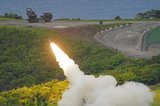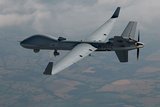Predator B ER completes Phase 1 flight testing
The Predator B Extended Range (ER) unmanned aerial vehicle (UAV) has completed its second successful long-endurance flight, bringing the system’s Phase 1 flight test period to an end.
The flight, which took place from 17-18 June, saw the Predator B ER demonstrate its ability to carry an external fuel tank on each wing, and used a new fuel management system which ensures fuel and thermal balance amongst all fuel sources, including the external tanks, the wing, and the fuselage.
The aircraft also demonstrated its Alcohol Water Injection (AWI) system, which shortens the required runway takeoff length, especially at higher gross takeoff weights, higher altitude take-offs, and on hot days; and improves climb out performance and fuel efficiency.
Frank W Pace, president, Aircraft Systems, General Atomics Aeronautical Systems, Inc, said: ‘This flight was a significant milestone for Predator B ER in that it closes out its Phase 1 flight test period. The entire [remotely piloted aircraft] system was successfully tested from start to finish, including flying a real-world representative mission with significant loiter time, and then returning to base.’
Introduced in 2012, GA-ASI is developing Predator B ER to extend Predator B's endurance and range greatly while also increasing its operational flexibility. The ER variant optimises the aircraft for intelligence, surveillance, and reconnaissance (ISR) missions with a projected increase in endurance from 27 to 33-35 hours by adding two external fuel tanks to its existing wings and heavy-weight landing gear to accommodate an increase in maximum gross takeoff weight.
GA-ASI is also funding an internal programme to develop an add-on ER option that optimises the aircraft for multi-purpose missions with a projected increase in endurance from 27 to 42 hours for ISR-only by replacing its current fuel-filled 66ft wings with 79ft wings. Completion of the first fuel-filled, longer wing is expected this summer, with the first test flight to follow before the end of the year.
Related Equipment in Defence Insight
More from Uncrewed Vehicles
-
![What's next for the Pentagon after the Replicator programme?]()
What's next for the Pentagon after the Replicator programme?
Although the Replicator initiative has made several accomplishments, there are still multiple gaps to plug across the US Department of Defense (DoD) and its services.
-
![Cummings Aerospace showcases Hellhound loitering munition designed for US Army’s LASSO programme (video)]()
Cummings Aerospace showcases Hellhound loitering munition designed for US Army’s LASSO programme (video)
Cummings Aerospace presented its turbojet-powered Hellhound loitering munition at SOF Week 2025, offering a man-portable solution aligned with the US Army’s LASSO requirements.
-
![SOF Week 2025: PDW unveils attritable FPV drone for SOF operations at scale]()
SOF Week 2025: PDW unveils attritable FPV drone for SOF operations at scale
PDW has revealed its Attritable Multirotor First Person View drone at SOF Week 2025, offering special operations forces a low-cost, rapidly deployable platform for strike and ISR missions, inspired by battlefield lessons from Ukraine.
-
![SOF Week 2025: Teledyne FLIR white paper provides guidance on reusable loitering munitions]()
SOF Week 2025: Teledyne FLIR white paper provides guidance on reusable loitering munitions
Teledyne FLIR is highlighting the emerging requirements for 'recoverable and re-usable' loitering munitions across the contemporary operating environment during this week’s SOF Week conference in Tampa, Florida.
-
![SOF Week 2025: Kraken Technology group debuts K3 Scout USV in North America]()
SOF Week 2025: Kraken Technology group debuts K3 Scout USV in North America
High-performance maritime industry player Kraken Technology Group, based in the UK, has used the SOF Week conference in Tampa, Florida this week to debut its K3 Scout uncrewed surface vessel (USV) to the North American market.
-
![Palladyne AI and Red Cat to demonstrate capabilities for autonomous drone swarms to the US military]()
Palladyne AI and Red Cat to demonstrate capabilities for autonomous drone swarms to the US military
Red Cat and Palladyne AI recently conducted a cross-platform collaborative flight involving three diverse heterogeneous drones.

























